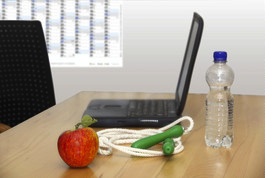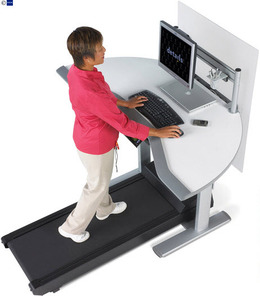Promoting Employee Health, Wellness and Productivity with Office Cubicles
Paying attention to proper ergonomics in the workplace is not just about avoiding employee injuries and liability claims - it has a much larger impact. The investment in a healthier and safer work environment can improve employee satisfaction, engagement, and productivity.
What was once thought of as only an insurance measure against future costs can actually be an investment in increasing productivity and employee retention. By making a few upgrades to little things such as modern office furniture, a company can reap large rewards.

Effects on productivity
It is no secret that happy, engaged employees are more productive and can increase a company's bottom line. What may be a surprise is that ergonomics can be a factor in how employees view their employers and whether they feel their employer values their contributions to the company.
Providing a safe, healthy work environment shows that an employer cares about employees' well-being and can promote engagement, thus leading to higher productivity.
Ways to improve the workplace to increase productivity
Making the workplace safer and more comfortable for all employees is the basics of ergonomics. OSHA defines this as "the science of fitting workplace conditions and job demands to the capabilities of the working population." For many businesses this means providing work areas that are fitted for comfortable use so that injuries are reduced, comfort is increased, and employees are happy in their environment.
Some ways to improve work areas are:
Well-fitted desks. Many modern desk designs allow for adjustable heights that allow employees to change the desk to fit their needs. Some options even allow for a desk to move from sitting to standing height, which gives them the freedom to stand and stretch their legs. These nontraditional options are gaining popularity.
Standing desks. Standing desks are on the rise and for good reason. They allow the individual to get up out of their seat to prevent back strain, and tired and achy muscles. Many of these desks are adjustable and actually transform from a traditional, seated work space to a standing one. Others are simply standing work stations.
Many experts say they increase productivity because the body is more alert when one is standing. This could be ideal for the person who experiences a mid-afternoon slump. Rather than going for a cup of coffee or treat, you simply stand up.
When considering this type of desk for your office, think about the floor too. The area around the desk should be cushioned to prevent back and knee strain and at the right height for each employee to make sure they are comfortable and maintaining the proper form.
Treadmill desks. Another nontraditional desk that more businesses are incorporating into their office space is the treadmill desk. This is an odd-looking piece of equipment for an office, but it has multiple uses. This desk is a traditional work space placed at standing height on a treadmill that moves.

The idea behind these types of nontraditional desks is to get employees moving. If they don't have time to work out after they leave the office, why not get their exercise while at the office? Some desks are placed on a bicycle-type machine to allow them to sit and work but still remain active. Others are on a standing treadmill. Settings should be kept low enough to lessen the risk of an accident. The view on having these types of nontraditional desks is that they help improve the person's physical health while they are working.
Office chairs. Quality work or office chairs can have a large impact on reducing back and neck injuries as well as keeping employees comfortable throughout the day. It is hard to be productive when his or her back or neck is aching.
Computers. Having computers that are designed for safety and ease of use can reduce eye strain and possible carpal tunnel injuries. Investing in ergonomic keyboards and anti-glare screens are all good investments.
Office environment and design
Many office designers provide design solutions that aim to enhance staff productivity, but they may not always think about employee health and wellness. When planning for a new office or to update your current design, consider the importance of the staff's health when final choices are being made.
The office's lighting should be bright enough to prevent eye strain, but not too bright to cause glare. Eye strain can result in headaches and poor performance -- or an increase in mistakes. In addition, place cabinets at a level that the employee can safely reach from the ground or can access with a sturdy step stool.
Consider flooring and how to choose the best patterns. Busy designs can cause headaches, and bright colors can create a glare. Don't forget to think about safety, either; it's a good idea to avoid floor mats or any material that can bunch up and trip workers. If your employees have to stand for quite a bit of their day, provide cushioning that stays firmly and place and won't curl up. This cushioning will help prevent back and knee pain.
Provide insulation that limits noise, and think about your color scheme, too. Certain colors can be either soothing or stimulating: Your colors will depend on what kind of workplace environment you want. If your employees work in customer service and have to speak to the occasional angry customer, you might want to consider calming colors. On the other hand, if your staff has to meet tight deadlines, you might prefer brighter, energizing colors.
When thinking about employee health and wellness based on your office design, communicate with workers and consider their needs or preferences. This not only includes design in reference to color and furniture, but it takes into account the layout of the space and the visual appeal of such things as artwork. What appeals to one age group or gender may not be as inspirational or beneficial to another group.
These small changes can make employees more comfortable throughout their day at work, by reducing pain and irritability that can accompany poorly equipped work areas. When employees see that their employers are investing in their comfort, they are more likely to be happier and satisfied with their jobs. These small improvements can have large impacts in morale and productivity, making them well worth the investment.
Ready to Compare Office Cubicles and Systems Price Quotes?